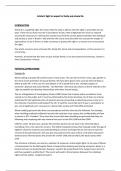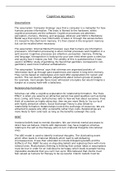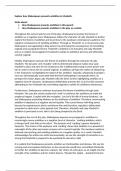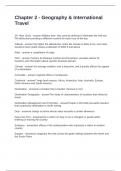Describe and evaluate Asch’s study:
The aim of Asch’s study was to investigate group pressure in an ambiguous situation. He
investigates this using 123 American men. Asch showed the participants two cards- one with a
standard line and the other with three comparison lines, he conducted 12 critical trials where
confederates gave the wrong answer. The results were, on the critical trials, the participants
gave the wrong answer ⅓ of the time and 25% of participants never gave the wrong answer.
Asch concluded that people are influenced by group pressure though many can resist. A
weakness of this study is that it is outdated- it is only reflective of conformity in 1950’s America
as Perrin and Spencer’s 1980 UK study showed much less conformity. Another weakness of the
study is that it was an artificial task- the task was trivial and the situation involved strangers so it
doesn’t reflect everyday situations. Finally, the sample used was unrepresentative so the results
cannot be generalized to collectivist cultures where Bond and Smith found that conformity rates
are higher.
Describe and evaluate Piliavin’s study:
The aim of Piliavin’s subway study was to investigate if characteristics of a victim affect help
given in an emergency. Piliavin conducted 103 trials where a male confederate collapsed on a
subway- the victim either appeared to be drunk or disabled (with a cane). He found that the
disabled victim was given help on 95% of the trials compared to the drunk victim who was only
helped on 50% of the trials. He also found that help was just as likely in crowded and empty
carriages. Piliavin concluded that characteristics of the victim does affect help given and the
number of onlookers doesn’t affect help in a natural setting. A strength of this study is that it has
high realism as the participants didn’t know their behavior was being studied, so acted more
naturally. Another strength of the study is that qualitative data was also collected as the
observers noted remarks from passengers giving deeper insights into why. A weakness of this
study is that an urban sample was used- all the participants were from the city so they may be
used to emergencies and therefore the results cannot be generalized.
Describe and evaluate Adorno’s theory of the authoritarian personality:
Adorno characterized the authoritarian personality as having a strong respect for authority and
looking down on people of a lower status, they have rigid stereotypes and don’t like change.
The authoritarian personality originates in childhood and comes from strict parents who show
conditional love (only show love when behavior is “correct”), these values are internalized and
children living in these conditions often seek a scapegoat who is socially inferior to take out the
hostility they feel towards their parents for being overly critical. A weakness of this theory is that
the authoritarian personality is measured on the F-scale which has response bias so it lacks
reliability. Another weakness of this theory is that the results could be correlational rather than
causational so one can’t conclude that the authoritarian personality causes greater obedience.
Finally, the theory doesn’t explain why (for example) Nazi Germans were obedient but did not all
have the same upbringing so social factors are also involved in obedience.
,Describe and evaluate Milgram’s agency theory:
Milgram’s agency theory proposed two states that people can be in- the agentic state and the
autonomous state. Being in the agentic state would mean that you follow orders with no
responsibility and being in the autonomous state would mean that you act on your own free
choice. We are more likely to obey orders when we are in an agentic state (when we believe we
are acting on behalf of an authority figure) because we believe the authority figure will take on
responsibility for our actions, and we no longer feel responsible. When someone we believe to
be a figure of authority gives us an order, we go from an autonomous state to an agentic state
(an agentic shift). A strength of this theory is that it has research support from Blass and Schmitt
who showed students a film of Milgram’s study and they blamed the experimenter rather than
the participants. A weakness of this theory is that it can't explain why there isn’t 100%
obedience in Milgram’s study so it is incomplete. Another weakness of this theory is that it is
potentially dangerous as it offers an excuse for destructive behavior.
Milgram’s shock study:
Milgram’s initial hypothesis: Germans must be different to all other nations due to their
involvement in the Holocaust, which is a dispositional approach as it assumes that obedience is
the result of personality factors rather than situational factors
○ A sample of 40 males aged 20-50 years old from a variety of different
backgrounds was obtained via volunteer sampling (leaflets and newspaper ads),
they were paid $4.50 for their time
○ Each participant was allocated the role of ‘Teacher’ seemingly at random (the
experiment was set up so that the participant was always ‘Teacher’)
○ The participant met ‘Mr Wallace’ who was a confederate of Milgram’s - the
participant assumed ‘Mr Wallace’ was another participant - he was in the role of
‘Learner’
○ The Learner was strapped into a chair and attached to electrodes; the Teacher
was shown this contraption before the procedure started
○ The Teacher, in another room, gave the Learner a trigger word which was
matched with a word that the Learner had (supposedly) memorised: the Learner
then pressed a button to indicate their answer
○ If the Learner got an answer wrong the Teacher had to issue an electric shock to
them via a shock generator which went from 15 volts to 450 volts (a lethal dose)
○ Throughout the procedure there was an experimenter present who provided
prompts if the Teacher seemed reluctant to go any further e.g. ‘The experiment
requires that you continue’
○ The Learner appeared to be making noises indicating pain which the Teacher
could hear e.g. ‘Get me out of here! Oh, that hurts!’
The dependent variable was measured as the number of participants who went up to 450 volts
plus the behavioral responses of the participants were also noted e.g. shaking, crying, 3 even
had a seizure. 65% of participants went up to 450 volts and 100% of participants went up to 300
volts.
, Milgram abandoned his dispositional hypothesis as his results showed that destructive
obedience is not a result of nationality or personal factors but is instead made possible by
specific situational factors
○ The situational factors which contributed to the participants’ high levels of
obedience were:
■ The experiment taking place at high-status Yale University i.e. it was
‘important’
■ The prompts were given by the experimenter who was wearing a lab coat
(authority figure)
■ The fact that the participants had volunteered to take part and had been
paid a small sum for doing so
■ The feeling that the situation was out of their hands and they were ‘just
obeying orders’ (agency theory)
Strengths:
1. A strength of this study is that it took place in a lab, this means extraneous variables can be
controlled so the cause and effect would be established and have reliability.
2. A strength of this study is that participants volunteered to take part , therefore there is no
experimenter bias
3.Another strength of this study is that qualitative and quantitative data was used , this is a
strength because the results give more information to support the conclusion made which
increases the validity .
Weaknesses:
1.Only males were used in the study , this may not be applicable to everyone ,this reduces
generalisability.
2. A weakness of this theory is that it had ethical issues as participants were promoted to keep
going even when uncomfortable, ethical conditions needed for a study is that participants should
be able to withdraw from the study at any time.
3.another weakness is that participants may have changed their behavior, due to the location of
where the study was conducted; in this case Yale university, which is not their usual
environment , therefore they may not have been acting naturally.
Describe Milgram’s study:
Aim: to see how an authority figure affects obedience by testing to see the number of
participants who went up by 450 volts.










